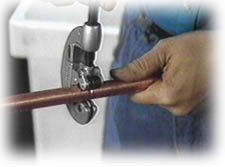 Steam heating systems are usually found in older homes, though they are still sometimes installed today. A steam boiler heats water to a boiling temperature creating super heated steam. The steam from the boiling water rises through the distribution system of piping and is delivered to either radiators or baseboard convectors. As the steam passes through the convection system and exchanges the heat into the air, it cools and returns to the boiler. A steam system operates at low pressure and has unique features for its operation such as low water cut off switches, automatic feed valves, glass gauges and other controls. Steam systems must be installed well or knocking from condensation in pipes, excess water use, or incomplete delivery of the steam may occur.
Steam heating systems are usually found in older homes, though they are still sometimes installed today. A steam boiler heats water to a boiling temperature creating super heated steam. The steam from the boiling water rises through the distribution system of piping and is delivered to either radiators or baseboard convectors. As the steam passes through the convection system and exchanges the heat into the air, it cools and returns to the boiler. A steam system operates at low pressure and has unique features for its operation such as low water cut off switches, automatic feed valves, glass gauges and other controls. Steam systems must be installed well or knocking from condensation in pipes, excess water use, or incomplete delivery of the steam may occur.
 Baseboard
Baseboard
Baseboard convectors can be used for either steam or hot water. They can be run along the walls in portions of the rooms and when installed correctly supply a very even method of heat distribution. Baseboard is used in steam usually when old cast iron radiators are removed. The professional inspector must check carefully to make certain there is heat in every room that is functional. If too much baseboard is installed then the rooms farther from the heating plant will not get adequate heat. If too little is installed then many of the rooms may be to cool or the system will not be efficient. Proper installation of the system is important to keep maintenance to a minimum.
 Radiators
Radiators
Radiators are used in either steam or hot water systems. They are usually seen only in older homes. Steam radiators look the same as hot water radiators except there is a steam check valve on them. This valve allows air out of the radiator when steam comes in and closes to prevent the steam from escaping. The inspector checks these radiators carefully because they can be prone to air binding, leaks and bad valves. Converting radiator systems to baseboard systems can be much more expensive than anticipated depending on the original piping installation.
 Piping
Piping
The piping system in a hot water or steam hydronic heating system delivers the heated element to the final convector used to exchange the heat. Pipes are usually made of steel, iron or copper. A proper design and installation of the piping system is crucial for the efficient and proper operation of your new home's heating system. Many older piping systems can be corroded or difficult to alter. They can also have asbestos, a commonly known health hazard, insulation. Most heat piping defects go undetected until a trained professional inspects the system.